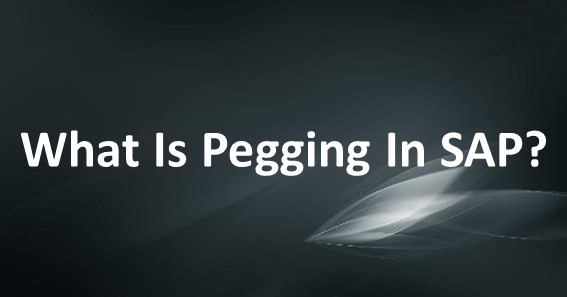Are you curious to know what is pegging in SAP? You have come to the right place as I am going to tell you everything about pegging in SAP in a very simple explanation. Without further discussion let’s begin to know what is pegging in SAP?
In the realm of enterprise resource planning (ERP) systems, SAP (Systems, Applications, and Products) is a name that resonates with businesses around the world. SAP offers a range of functionalities to streamline and optimize various business processes. One such feature that holds importance for inventory management and supply chain operations is “pegging.” In this blog, we will delve into the concept of pegging in SAP, understanding its significance, applications, and benefits for businesses.
What Is Pegging In SAP?
Pegging is a term used in SAP to describe the association or linkage between different documents or objects within the system. Specifically, pegging plays a critical role in tracking the relationships between supply and demand elements within the context of material requirements planning (MRP) and production planning.
In simpler terms, pegging helps businesses trace the connections between various demands for materials (such as sales orders, purchase orders, and production orders) and the corresponding supply elements (such as raw materials, components, and finished goods). This linkage is established to provide a clear picture of how different demands are fulfilled based on available or planned supply.
Applications Of Pegging
- Demand-Supply Linkage: Pegging allows businesses to visually and systematically determine how specific customer orders or sales demands are fulfilled by correlating them with the corresponding production or procurement orders.
- Root Cause Analysis: In cases of supply chain disruptions or delays, pegging helps identify the source of the issue by tracing the dependencies between various orders and understanding where the chain was disrupted.
- Efficient Resource Utilization: Pegging aids in optimizing resource utilization by enabling businesses to prioritize production or procurement orders based on the most critical customer demands.
- Lead Time Management: By linking demand with supply, pegging provides insights into lead times, enabling businesses to manage expectations and communicate accurate delivery dates to customers.
Benefits Of Pegging In SAP
- Enhanced Visibility: Pegging offers a clear and comprehensive view of the relationships between orders, enabling businesses to make informed decisions based on real-time information.
- Quick Response to Changes: With pegging, businesses can quickly adapt to changes in customer demand, supply availability, or unexpected disruptions, ensuring a responsive supply chain.
- Reduced Inventory Costs: By linking demands with supplies accurately, pegging helps minimize excess inventory, leading to cost savings.
- Improved Customer Satisfaction: Pegging aids in meeting customer expectations by ensuring that critical orders are prioritized and fulfilled on time.
Conclusion
Pegging is a fundamental concept within SAP that plays a pivotal role in ensuring effective inventory management, demand fulfillment, and overall supply chain efficiency. By establishing clear associations between demands and supplies, businesses can navigate complex supply chain scenarios with greater visibility and accuracy. As organizations continue to harness the power of SAP and other ERP systems, understanding the nuances of features like pegging becomes essential to unlocking operational excellence and delivering superior customer experiences.
You can search for more information on Snorable
FAQ
What Does Pegging Mean In Mrp?
The APICS dictionary defines pegging as: “In MRP and MPS, the capability to identify for a given item the sources of its gross requirements and/or allocations.”.
What Is Pegging Area In SAP?
Pegging is a concept in SAP APO Production Planning and Detailed Scheduling (PP/DS) to ‘link’ a receipt element with a requirement element. A Pegging Area in the context of SAP APO PP/DS is a combination of product, location, account assignment object and planning version.
What Is Pegging In Inventory?
Pegging links demand to incoming supply. You can create a peg chain between a supply transaction and a demand transaction from either side. Demand transactions can peg to supply transactions and vice versa. A peg prevents the incoming supply from being reserved, or allocated to another demand transaction.
What Is Pegging In Retail?
Pegging is the process of setting a fixed rate of exchange for a currency with that of another. Domestic Currency is a medium of transaction within a country. This is also called as the Primary Currency. Foreign Currency is the one used outside a country for monetary exchange.
I Have Covered All The Following Queries And Topics In The Above Article
What Is Pegging In SAP
What Is Pegging In SAP
What is the process of pegging






